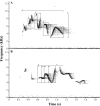A striking new species of leaf warbler from the Lesser Sundas as uncovered through morphology and genomics - PubMed (original) (raw)
A striking new species of leaf warbler from the Lesser Sundas as uncovered through morphology and genomics
Nathaniel S R Ng et al. Sci Rep. 2018.
Abstract
Leaf warblers (Aves; Phylloscopidae) are a diverse clade of insectivorous, canopy-dwelling songbirds widespread across the Old World. The taxonomy of Australasian leaf warblers is particularly complex, with multiple species-level divergences between island taxa in the region requiring further scrutiny. We use a combination of morphology, bioacoustics, and analysis of thousands of genome-wide markers to investigate and describe a new species of Phylloscopus leaf warbler from the island of Rote in the Lesser Sundas, Indonesia. We show that this new Rote Leaf Warbler is morphologically and genomically highly distinct from its congenerics, but do not find vocal differentiation between different island taxa. We discuss the behaviour and ecology of this highly distinctive new species, and make recommendations about its conservation status. We believe this constitutes the first description of a novel bird species that is partly based on insights from massive amounts of genome-wide DNA markers.
Conflict of interest statement
The authors declare no competing interests.
Figures
Figure 1
Maps showing location of Rote island in Wallacea (inset) and field localities on Rote Island: Seda forest (A) and woodland close to Bolatena village on the Tapuafu peninsula (B). Map data: Google, DigitalGlobe.
Figure 2
Sonogram of two song types (A–B) from recording XC302571 (Timor), with each panel depicting a single strophe. Vocal characters: (1) strophe duration, (2) an example of a descending element, (3) an example of an ascending element, (4) an example of a V-shaped element, (5) another example of a descending element, (6) an example of a ∧-shaped element, (7) bandwidth frequency of a strophe, (8) an example of a complex element that is further divided into four parts, (i and iii) ∧-shaped, (ii and iv) V-shaped, (9) highest frequency of a strophe, (10) lowest frequency of a strophe.
Figure 3
Pictures from the field of the newly described Rote Leaf Warbler (on the left; PV) and the Timor Leaf Warbler P. presbytes from Mount Ramelau in Timor Leste (on the right; CT). The unusually long, colourful bill and overall more saturated yellowish plumage of the Rote Leaf Warbler are apparent.
Figure 4
Results from PCA analysis show leaf warbler populations from Peleng (n = 1), Rote (n = 1) and Timor (n = 2) to be genomically distinct. PC1 and PC2 refer to Principal components 1 and 2 respectively.
Figure 5
Results of maximum likelihood (ML) tree inference as applied to the mitochondrial cytochrome-b locus. Both ML and maximum parsimony (MP) returned identical tree topologies. The ML tree is used here, and branch lengths represent relative genetic distance. Node support higher than 70 is shown and represents values from ML and MP analyses respectively. The Timor Leaf Warblers cluster together with high branch support to the exclusion of the Rote Leaf Warbler.
Figure 6
Maximum Likelihood tree from concatenated genomic read data (1,443,756 bp from 10,064 loci). Branch lengths reflect relative genetic distance. Branch support values higher than 70 are shown.
Figure 7
Principal component analysis plots of (A) songs [9 parameters] and (B) calls [19 parameters] of the Lesser Sundaic Phylloscopus leaf warblers. Ellipses represent 95% confidence intervals of each taxon.
Similar articles
- Complete species-level phylogeny of the leaf warbler (Aves: Phylloscopidae) radiation.
Alström P, Rheindt FE, Zhang R, Zhao M, Wang J, Zhu X, Gwee CY, Hao Y, Ohlson J, Jia C, Prawiradilaga DM, Ericson PGP, Lei F, Olsson U. Alström P, et al. Mol Phylogenet Evol. 2018 Sep;126:141-152. doi: 10.1016/j.ympev.2018.03.031. Epub 2018 Apr 6. Mol Phylogenet Evol. 2018. PMID: 29631054 - Mitochondrial phylogeny of the Eurasian/African reed warbler complex (Acrocephalus, Aves). Disagreement between morphological and molecular evidence and cryptic divergence: A case for resurrecting Calamoherpe ambigua Brehm 1857.
Olsson U, Rguibi-Idrissi H, Copete JL, Arroyo Matos JL, Provost P, Amezian M, Alström P, Jiguet F. Olsson U, et al. Mol Phylogenet Evol. 2016 Sep;102:30-44. doi: 10.1016/j.ympev.2016.05.026. Epub 2016 May 24. Mol Phylogenet Evol. 2016. PMID: 27233439 - Conflicting patterns of mitochondrial and nuclear DNA diversity in Phylloscopus warblers.
Bensch S, Irwin DE, Irwin JH, Kvist L, Akesson S. Bensch S, et al. Mol Ecol. 2006 Jan;15(1):161-71. doi: 10.1111/j.1365-294X.2005.02766.x. Mol Ecol. 2006. PMID: 16367838 - Non-monophyletic taxa and cryptic species--evidence from a molecular phylogeny of leaf-warblers (Phylloscopus, Aves).
Olsson U, Alström P, Ericson PG, Sundberg P. Olsson U, et al. Mol Phylogenet Evol. 2005 Aug;36(2):261-76. doi: 10.1016/j.ympev.2005.01.012. Epub 2005 Mar 4. Mol Phylogenet Evol. 2005. PMID: 15955509 - Origin and population history of a recent colonizer, the yellow warbler in Galápagos and Cocos Islands.
Chaves JA, Parker PG, Smith TB. Chaves JA, et al. J Evol Biol. 2012 Mar;25(3):509-21. doi: 10.1111/j.1420-9101.2011.02447.x. Epub 2012 Jan 13. J Evol Biol. 2012. PMID: 22239606
Cited by
- The formation of the Indo-Pacific montane avifauna.
Reeve AH, Kennedy JD, Pujolar JM, Petersen B, Blom MPK, Alström P, Haryoko T, Ericson PGP, Irestedt M, Nylander JAA, Jønsson KA. Reeve AH, et al. Nat Commun. 2023 Dec 11;14(1):8215. doi: 10.1038/s41467-023-43964-y. Nat Commun. 2023. PMID: 38081809 Free PMC article.
References
- del Hoyo, J. & Collar, N. J. HBW and BirdLife International illustrated checklist of the birds of the world. Volume 2: Passerines. (Lynx Edicions, 2016).
- Rheindt FE. Splits galore: the revolution in Asian leaf warbler systematics. BirdingAsia. 2006;5:25–39.
- Martens J. A preliminary review of the leaf warbler genera Phylloscopus and Seicercus. Br. Ornit. Club Occ. Publ. 2010;5:41–116.
- Alström P, Olsson U, Lei F. A review of the recent advances in the systematics of the avian superfamily Sylvioidea. Chinese Birds. 2013;4:99–131. doi: 10.5122/cbirds.2013.0016. - DOI
- Rheindt FE, Hutchinson RO. A photoshot odyssey through the confused avian taxonomy of Seram and Buru (southern Moluccas) BirdingAsia. 2007;7:18–38.
Publication types
MeSH terms
Substances
LinkOut - more resources
Full Text Sources






